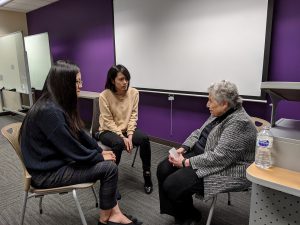
Over half of adults in the U.S. have a chronic disease, according to the CDC. Symptom self-management can be a key part of helping people with chronic diseases live a healthy and longer life.
“I don’t look at self-management so much as a theory, rather as something someone does,” said Dr. Kate Lorig, partner at the Self-Management Resource Center and professor emerita at Stanford University, in her February 6 talk at the UW School of Nursing.
Lorig walked the audience through her career developing self-management programs, from her dissertation to the current day, highlighting the groundbreaking work she has done and sharing her insights on navigating the world of research and academia.
Lorig prefers the Institute of Medicine’s 2014 definition of self-management, which defines it as “Tasks that individuals must undertake to live with one or more chronic conditions. Tasks include having confidence to deal with medical management, role management, and emotional management of their conditions.”
The management programs she developed involve groups of people meeting regularly with a facilitator and creating their own action plans for how they want to manage their chronic diseases.
“We never tell anyone what to do,” Lorig said. “Every class someone is doing something different.”
For her dissertation, Lorig developed an arthritis self-management program, hypothesizing that improving knowledge and behaviors would improve participants’ health. However, while there were improvements, the statistics didn’t show a strong benefit of the program – the improvements didn’t seem connected and may have been due to chance. But, encouraged by her mentors, she stuck with the work and eventually it paid off.
Since then, the programs she’s developed have shown success across numerous chronic diseases, improving participants’ energy levels, depression levels, self-rated health, and reducing the days they spent in the hospital. That last one is key, Lorig said, as showing lower health care usage can help get research translated into policy.
 Lorig emphasized the importance of “thinking outside the box, but not too far outside the box” for researchers. Stick with novel research, but work within the system. Make studies that can be replicated and pick outcomes that policymakers care about. Know what major funders and organizations in the field are looking for and collaborate with people who know the field well.
Lorig emphasized the importance of “thinking outside the box, but not too far outside the box” for researchers. Stick with novel research, but work within the system. Make studies that can be replicated and pick outcomes that policymakers care about. Know what major funders and organizations in the field are looking for and collaborate with people who know the field well.
When she and her team ventured into diabetes management, they knew early on it would be controversial. So they worked with a respected person in the field, the former president of the American Diabetes Association, who contributed her extensive knowledge and wisdom about diabetes research to help them develop and gain support for the program in the diabetes health community.
“If you’re going to leap into the firestorm, have a friend,” Lorig said.
During her talk, Lorig also shared advice that the de Tornyay Center for Healthy Aging’s namesake and benefactor, Dr. Rheba de Tornyay, once gave her about the secret to success: ask people what their problems are, reflect back to them what you heard, and carry a briefcase.